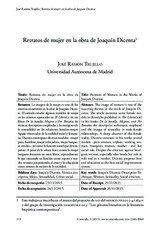Retratos de mujer en la obra de Joaquín Dicenta
Portraits of Women in the Works of Joaquín Dicenta
Autor
Trujillo, José Ramón
Editor
Universidad de Córdoba, UCOPressFecha
2015Materia
Joaquín DicentaTécnica descriptiva
Mujer
Sensualidad
Crítica social
Descriptive Technique
Woman
Sensuality
Social criticism
METS:
Mostrar el registro METSPREMIS:
Mostrar el registro PREMISMetadatos
Mostrar el registro completo del ítemResumen
La imagen de la mujer es uno de los
motivos recurrentes en la obra de Joaquín Dicenta.
El artículo estudia algunos modelos de mujer
en las crónicas aparecidas en El Liberal y en sus
libros De la batalla, Mujeres y Por Bretaña; las
técnicas descriptivas empleadas y las imágenes de
la sensualidad en las relaciones hombre-mujer.
Agudo observador de la realidad social y femenina,
Dicenta contrapone diversos modelos –mujer
pura, huérfana, mujer trabajadora, mujer burguesa,
madre–, así como la función social que desempeñan.
A pesar de la crítica feroz contra la mujer
burguesa frecuente en otros libros, especialmente
la que incumple su función como esposa y madre,
termina proponiendo el amor y la educación
como sistema de mejora de la sociedad. The image of women is one of the
recurring themes in the work of Joaquín Dicenta.
The article examines some female models
in chronicles published in The Liberal and
in his books De la batalla, Mujeres, and Por
Bretaña; the descriptive techniques employed
and the images of sensuality in male-female
relationships. A sharp observer of the female
reality, Dicenta contrasts in his works several
models –pure woman, orphan, working woman,
bourgeois woman, mother– and her
social role. Despite the criticism against bourgeois
woman, especially who breaks her role as
wife and as a mother, Dicenta proposes love
and education as the best social improvement
system.

